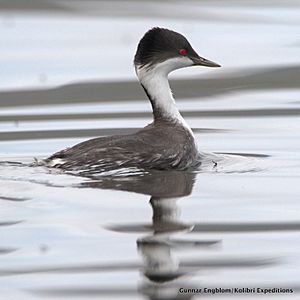Junin grebe facts for kids
Quick facts for kids Junin grebe |
|
|---|---|
 |
|
| Conservation status | |
| Scientific classification | |
| Genus: |
Podiceps
|
| Species: |
taczanowskii
|
 |
|
The Junín grebe (Podiceps taczanowskii) is a very special bird. It is also known as the Junin flightless grebe. This grebe lives only in one place: Lake Junin in the highlands of Peru.
These grebes build their nests in the tall reeds around the edge of the lake. They go into the reeds to lay eggs or to rest. When they are not nesting, Junin grebes like to swim in the open water. They often move far away from the lake shores. Sadly, there are fewer than 250 of these birds left in the world.
Its scientific name honors a Polish scientist named Władysław Taczanowski. He wrote a book about the birds of Peru. Another rare bird, the Junin rail, also lives only in Lake Junin.
Contents
What the Junín Grebe Looks Like
The Junín grebe is about 35 centimeters (14 inches) long. It has a dark gray head and back. Its face, neck, and belly are white. The bird has a thin gray beak. One of its most amazing features is its bright red eyes!
Adult grebes have shiny silver-gray feathers on the sides of their heads. Young grebes and adults not ready to breed do not have these feathers.
The Junín grebe makes different sounds. Its calls include pretty whistles like doo’ ith and wit. When it wants to find a mate, it makes a longer sound like phooee-th.
How the Junín Grebe Lives
Reproduction and Life Cycle
When two Junín grebes are ready to mate, they do a special dance. They face each other, chest to chest, and quickly shake their heads from side to side. This is called 'head-shaking'.
Junín grebes build their nests in the reed beds around Lake Junin. They usually lay two eggs in December or January. If the lake's water level is very low, the birds might not be able to raise any young that year.
What the Junín Grebe Eats
The Junín grebe is an excellent diver. This helps it catch small fish and tiny water animals called invertebrates. You can often see them diving and feeding together in small groups.
Where the Junín Grebe Lives
The Junín grebe lives only in Lake Junin in west-central Peru. This means it is endemic to this one lake. The lake is about 140 square kilometers (54 square miles) in size. It is about 10 meters (33 feet) deep at its deepest point. However, most of the lake is less than 5 meters (16 feet) deep. There are many reed marshes around the lake's edges. These reeds are where the grebes build their nests and rest.
Protecting the Junín Grebe
Lake Junin became a national reserve in 1974. This helped to limit fishing and hunting in the area. In 2002, the Peruvian government passed a special law. This law aimed to stop too much water from being taken from the lake. It also aimed to clean up the lake. However, this law has not been fully put into action yet.
Scientists have tried to move some grebes to another lake nearby. But this did not work well because of fishing nets used there. More studies are being done to find other safe lakes for the Junín grebe.
The number of Junín grebes has dropped a lot. In 1961, there were about 1000 grebes. By 2007, there were only about 200 left. This is because of two main problems:
- Changing Water Levels: A nearby hydroelectric power plant can cause the lake's water level to change a lot. If the water drops below 5 meters (16 feet), the birds cannot raise their chicks. Low water also harms the reed marshes where they nest.
- Water Pollution: Waste from mining activities pollutes the lake. This pollution kills the small fish that the Junín grebes eat.
A local group called Asociaciόn Ecosistemas Andinos is working to help. They teach local people about the Junín grebe and the Junin rail. Both birds are found only in this lake. The group wants to make people aware of the problems. They also want the mining and power plant companies to understand the issues.
See also
 In Spanish: Zambullidor de Junín para niños
In Spanish: Zambullidor de Junín para niños


